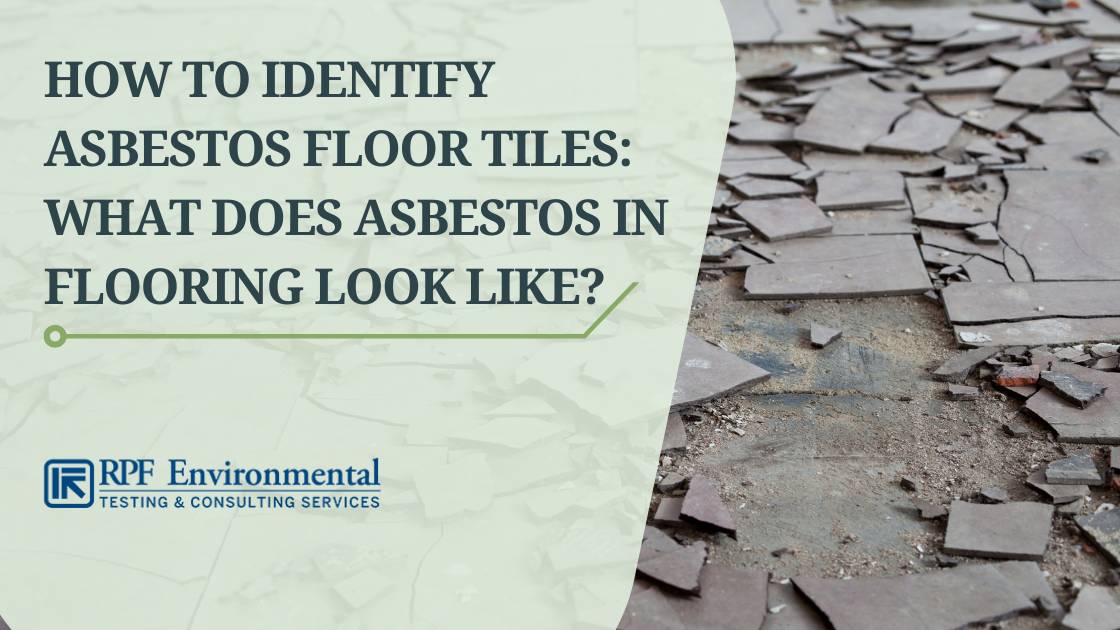If you suspect the presence of asbestos in your house and are wondering what asbestos in flooring looks like, this short guide can help you. This article will discuss how you can identify flooring that might contain asbestos through visual inspection along with tips on how to deal with them. If you don’t want to put your family at risk of exposure to toxic asbestos when doing any renovation or remodeling activity in your home, we recommend hiring a professional asbestos inspector.

RPF Environmental helps homeowners and businesses keep their environment safe through our professional asbestos testing and inspection services. We serve areas throughout the country including, but not limited to Illinois, Indiana, Maine, Massachusets, and New Hampshire. Contact us now!
What is Asbestos Flooring?
Due to the durability, heat resistance, and fire resistance of asbestos, it was included in many building materials including flooring. It was used in high concentrations to manufacture floor tiles from the 1920s to the 1970s. These asbestos flooring were installed in high-traffic areas like kitchens, hallways, entryways, mudrooms, and bathrooms in homes built before the 1980s.
Different Types of Asbestos Flooring: What Does Asbestos Flooring Look Like? What Is the Color of Asbestos Tiles?
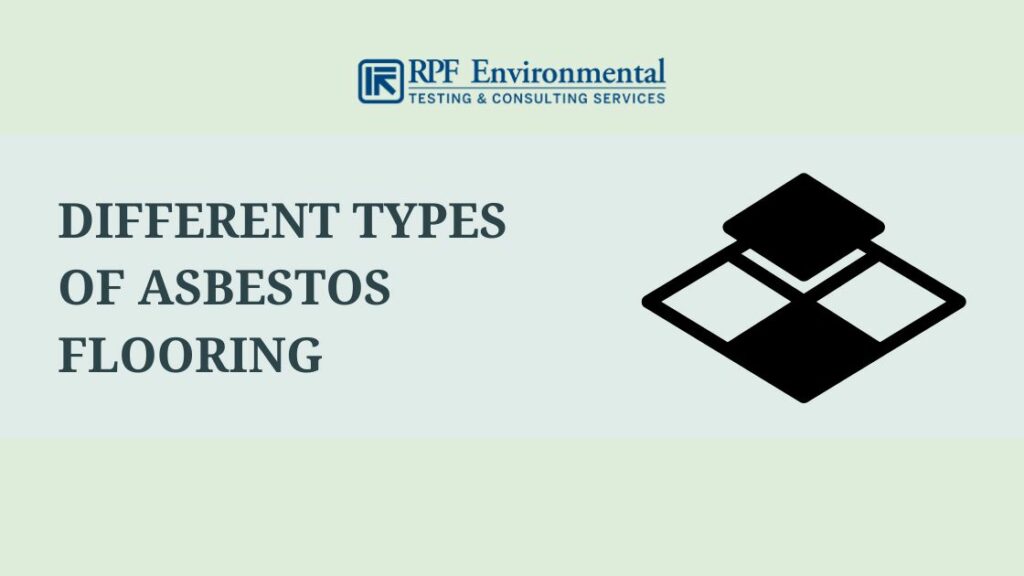
Although professional laboratory testing is the only way to accurately identify asbestos-containing materials (ACM), visual identification is possible in many cases when it comes to asbestos flooring.
Asbestos flooring mostly came in the form of vinyl tiles, but other types of flooring like linoleum and vinyl sheet flooring may also contain asbestos backing.
How Do You Identify Asbestos Vinyl Flooring?
Asbestos vinyl tiles can come in any design and color, but you’ll often find them in light blue, cream, pink, or green colors. Asbestos was mixed into vinyl floor tiles for improved insulation as well as enhanced fire and damage resistance. Aside from houses, they were also used in commercial buildings, hospitals, and schools. Moreover, the glue used in installing these tiles also contains asbestos.
What Does Asbestos Sheet Flooring Look Like?
Asbestos vinyl sheet flooring can come in white, blue, and brown colors and are more aesthetically pleasing options compared to vinyl tiles. They were often designed to look like carpeting, stone, or wood flooring. Although the sheet itself doesn’t contain asbestos, the backing that serves as a cushion contains high asbestos concentrations.
What Does Asbestos Linoleum Look Like?
Aside from vinyl sheet flooring, asbestos was also used in the asphalt-impregnated felt paper or black tar paper-like backing material of linoleum sheet flooring. Moreover, linoleum appears similar to vinyl flooring. This is why homeowners often mistake it for vinyl flooring.
Other Tips on How to Identify Asbestos in Flooring
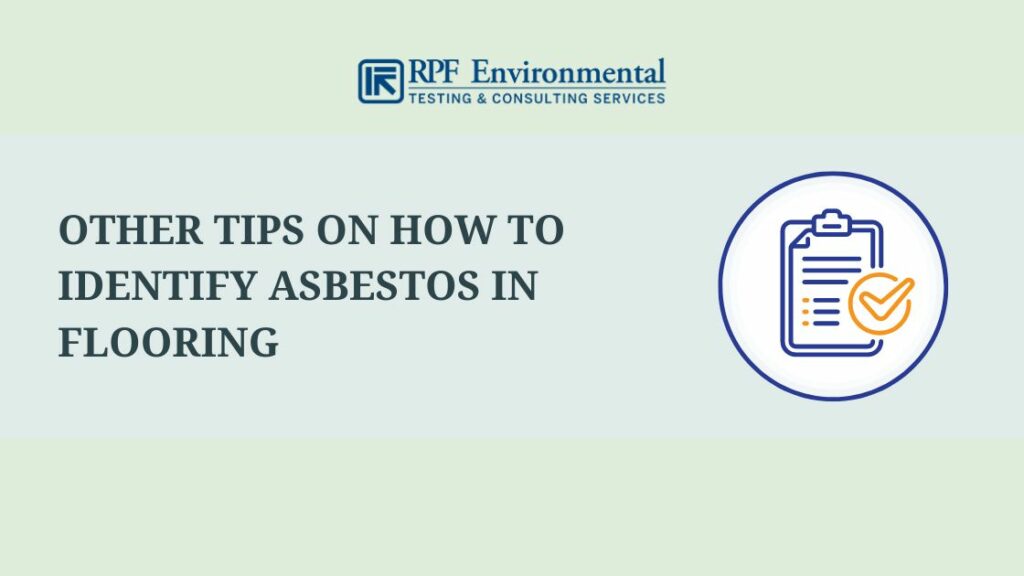
In addition to the specific features we’ve mentioned, below are other ways on how you can identify asbestos vinyl, vinyl sheet, and linoleum flooring in your home/business:
1. Determine the Manufacturer & Brand Name of the Asbestos Flooring
Find the manufacturer of the flooring by loosening one tile and then wiping off the glue. You should find details about the manufacturer written on the back.
Manufacturers of Asbestos Flooring
Below is a list of some of the most popular manufacturers of asbestos-containing flooring:
- American Biltrite
- American Olean Tile Company
- Amtico Floors
- Armstrong World Industries
- Fibreboard Corporation
- Congoleum Corporation
- EverWear Inc.
- Flintkote Company
- General Aniline & Film (GAF) Corporation
- Goodyear
- Kentile Floors
- Montgomery Ward
- Sears-Roebuck
You can check InspectApedia’s Index to Asbestos Flooring Identification Guides for more information on how to identify specific asbestos flooring types by brand.
2. Determine the Age of the Asbestos Tiles
Some asbestos flooring materials were manufactured as early as the 1920s and used in many houses up to the 1970s. So if your home was built within this timeframe, there is a high chance that your flooring contains asbestos. However, this doesn’t guarantee that your home is free from asbestos if it was built later than the 1970s.
3. Inspect Certain Physical Characteristics of the Flooring
Check any discoloration in the flooring, the tile size, and the color of the adhesive used:
Signs of Discoloration
Asphalt-based asbestos floor tiles may appear discolored or oily. Asphalt, which is one of the main materials in manufacturing asbestos tiles, can degrade over time and seep out. This causes dark stains in the tiles which will make them appear grimy.
Size of the Tile
Asbestos floor tiles mostly came in 9″ x 9″ sizes, but they were also sold in 12″ x 12″ and 18″ x 18″ sizes. They are also a bit thicker compared to modern tiles.
Asbestos in Flooring Adhesives
Thick black flooring adhesive underneath the tiles can also indicate the presence of asbestos. Black mastic or cutback adhesive was popularly used for installing flooring prior to the 1980s and most likely contains asbestos.
4. Get Your Flooring Tested for Asbestos in an Accredited Laboratory
If you want to identify asbestos flooring in your home/business more accurately, have a certified asbestos inspector do the job. An asbestos inspection involves collecting samples and testing them in an accredited laboratory to get reliable and accurate results. This way, you’ll be able to plan effectively before you do your renovation or remodeling projects without putting your family at risk of toxic asbestos exposure.
Note: Avoid cutting flooring samples yourself unless local laws allow you to. Some areas restrict asbestos testing to certified experts only.
Also Read: Do Home Inspections Check for Asbestos?
Note: Not All Old Tile or Sheet Flooring Contains Asbestos
Take note that not all old flooring tiles manufactured before the 1980s contain asbestos. Some lines of vinyl floor tiles, like Excelon Supreme, including some asphalt-based tiles resembling 9″ x 9″ asbestos-containing flooring don’t contain asbestos.
The Dangers of Asbestos-Contaminated Flooring Exposure to the Health
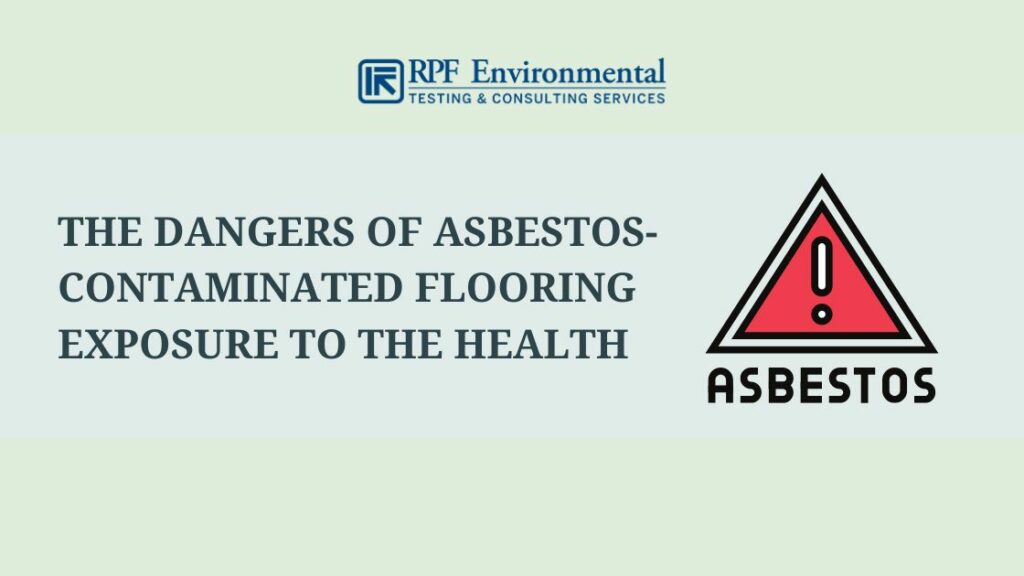
Asbestos-containing floor tiles are not always dangerous. As long as they are in good condition and undisturbed, they are not likely to pose a serious health risk.
When Are Asbestos Floor Tiles Dangerous?
According to the EPA, asbestos exposure may only occur when the material is damaged or disturbed which will release fibers into the air that you can’t detect by smell or sight. Activities like the following will increase the friability of the asbestos flooring and cause the fibers to become airborne:
- Demolition work
- Home or building maintenance
- Repair
- Remodeling
- Buffing
- Sanding
- Drilling
- Grinding
- Sawing
- Water damage
- Physical aging
- Continuous vibration
When the fibers are released into the air, you can easily inhale them unknowingly which can lead to serious health risks such as:
- Asbestosis
- Mesothelioma
- Lung cancer
- Throat cancer
- Kidney cancer, etc.
Encapsulation & Removal: How to Deal With Asbestos Floor Tiles in Your Home
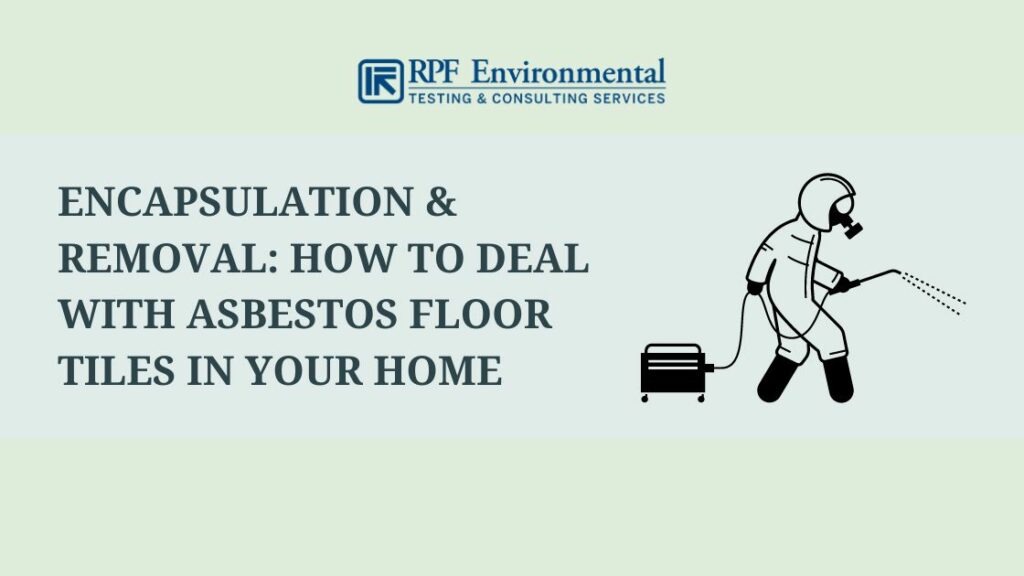
Asbestos floor tiles, including other asbestos-containing products, can be removed, encapsulated, or covered:
Asbestos Flooring Encapsulation
For tiles that are in good condition, you can cover the old asbestos flooring with carpeting or new flooring to prevent the fibers from becoming airborne. Old asbestos tiles are only about ⅛-inch thick which won’t raise your floor height significantly if you install new flooring. However, take note that encapsulation isn’t a long-term solution. Asbestos may become airborne once the tiles degrade or are disturbed.
Asbestos Floor Tiles Removal
Only certified asbestos abatement professionals should remove asbestos flooring in your home. Removal is the best option if you want to guarantee long-term safety and completely get rid of asbestos from your home.
The Process of Removing Asbestos-Contaminated Flooring
Below is an overview of the asbestos flooring removal process:
1. The professionals will seal the area to prevent asbestos fibers from spreading during the removal process.
2. They will wet the materials and then remove them.
3. Special HEPA vacuums will be used to clean surfaces.
4. The materials are disposed of.
How Much Does It Cost to Remove Asbestos Tiles?
Removing asbestos flooring and flooring tiles can cost from $5 to $15+ per square foot, not including replacement costs. Read more on asbestos removal costs here.
What to Know About DIY Asbestos Flooring Removal
We don’t recommend DIY asbestos removal and you shouldn’t attempt it unless it is legal in your area. However, make sure to follow local guidelines for asbestos removal and disposal if you choose to do it yourself. Also, some places require a permit before you can remove asbestos materials. Contact your local building authority before removal to make sure that you are doing the process safely and legally.
FAQs
Some signs you can look for that may indicate asbestos in your flooring include:
– Discoloration
– Oily look
– 9″ x 9″, 12″ x 12″, and 18″ x 18″ tile sizes
– Black flooring adhesive
– Manufactured before the 1980s
Asbestos flooring can come in the form of vinyl tile, vinyl sheet, linoleum, or laminate flooring.
Yes, inhaling airborne fibers from damaged or disturbed asbestos flooring can cause serious health complications including asbestosis, mesothelioma, and lung cancer.
Conclusion
Although you can identify potential asbestos-containing flooring through visual inspection, professional testing by a licensed asbestos inspector is the best way to get accurate results. Have your home or business professionally tested for asbestos first before doing any renovation or remodeling activities to ensure safety and avoid future liabilities.
You can rely on RPF Environmental for affordable asbestos testing and inspection services. We have certified professionals that have been conducting environmental inspections in Maine, Massachusetts, New Hampshire, and beyond. Contact us now!

